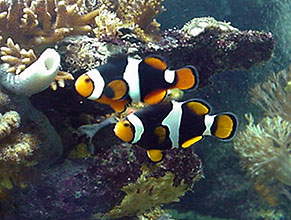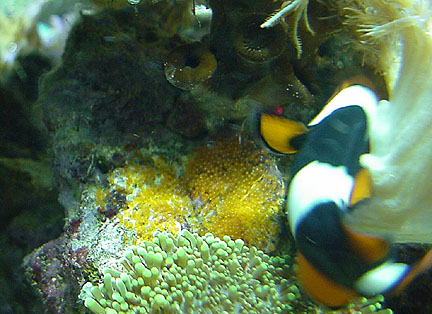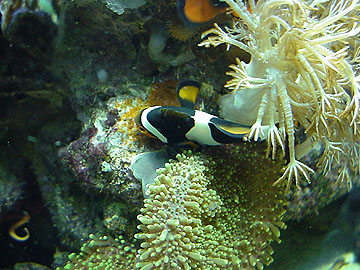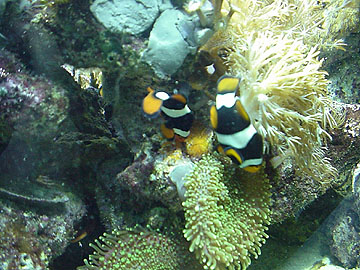

Captive-bred pair of Solomon Island Black Percula Clownfish, Amphiprion percula
Top fish male, larger fish below is female
(August 23, 2000, photo taken a few hours before they laid the eggs shown below)
These fish were produced by C-Quest , an ornamental marine fish propagation facility in Puerto Rico, and purchased in early Fall 1998 from Inland Aquatics (Terre Haute, Indiana)
Click for much more clownfish information and older photo of these fish
Clownfish Breeding Behavior
This pair has been spawning every two weeks since mid Spring 2000. They lay their orange eggs on rocks near the base of the Xenia elongata soft coral colony (to the right of the eggs in these photos) that they use as a surrogate host in the absence of a host anemone. All spawnings that have been observed have been in late afternoon-early evening, and are preceeded earlier in the day by vigorous cleaning of the spawning site by both parents (the parents bite repeatedly at the rock to clean it).
Shortly before and during spawning, a small blunt-ended spawning tube (an ovipositor from which eggs will be released) protrudes slightly from the female's vent. In the male a similar but smaller tube appears for release of sperm. During spawning, the female first swims slowly over the spawning site with her ovipositor in contact with the rock, attaching her oval-shaped eggs to the rock as she does so. When she is done, the male releases sperm over the eggs as he makes a similar pass over the spawning site. The female then lays more eggs, and the male fertilizes them. They trade off like this for 1 to 3 hours until all eggs have been laid.
The photo below shows the male with the orange eggs about an hour after spawning was completed.

For about 8 days after spawning, the male visits and tends the eggs repeatedly during the course of the day, fanning the eggs with his pectoral fins and mouthing them frequently. Meanwhile, the larger female may also tend the eggs a bit (see first photo below) but normally she pays little or no attention to the eggs after spawning. Instead, her role is to vigorously defend the pair's territory from intruders that could threaten the eggs.
The photos below show the female (first photo) and male (second photo) tending the eggs shortly after they were laid.


As the embyos develop, the eggs gradually darken in color, becoming grey with a set of conspicuous dark eyes visible within each egg. During the last few days before hatching, portions of the eyes shine metallic silver through the egg coats. The eggs hatch at night, shortly after lights go out, with the entire clutch hatching more or less at the same time. At this point parental care is over, and the 3mm long larvae begin a planktonic existence. In the wild, this planktonic phase spent drifting near the ocean surface would last 7 to 21 days, depending on the clownfish species. After this planktonic period, the young fish (now roughly 12 mm in length) undergo a metamorphosis that converts them into miniature versions of the adults, and they settle out of the plankton onto the reef or nearby habitats. These young clownfish are very vulnerable to predation at this time and must promptly find and acclimate to a host anemone to gain protection from predators.
In our aquaria, the larval fish quickly become food for other creatures in the tanks, and even if they were not eaten they would starve due to inadequate microscopic prey for them to feed upon. To raise these young fish past the larval stage we would need to scoop them out shortly after hatching and rear them in separate aquaria. Rearing larval clownfish is quite a lot of work, however, since not only do you need to raise the larval fish, but you need to raise food to feed them. The first food used to feed larval clownfish in captivity is typically marine rotifers, and to keep rotifer cultures going one needs to grow large cultures of the planktonic marine algae the rotifers feed on. After the larval clownfish grow large enough to swallow larger prey, they are typically fed newly hatched brine shrimp (which are easier to provide than the rotifers). One they undergo metamorphosis the baby clownfish are fairly easy to raise.